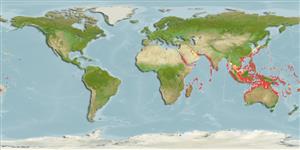Common names from other countries
Environment: milieu / climate zone / depth range / distribution range
Ecologia
marinhas associadas(os) a recifes; intervalo de profundidade 0 - 55 m (Ref. 26165), usually 5 - 35 m (Ref. 27115). Tropical; 22°C - 28°C (Ref. 27115); 35°N - 36°S, 24°E - 169°W
Indo-West Pacific: Red Sea and Natal, South Africa to Niue (Ref. 37816), north to Japan, south to Australia. Recorded from Europa Island (MNHN 1992-0508).
Tamanho / Peso / Idade
Maturity: Lm ? range ? - ? cm
Max length : 15.0 cm TL macho/indeterminado; (Ref. 9710); 7.0 cm TL (female)
Espinhos dorsais (total) : 10; Raios dorsais (total) : 15 - 17; Espinhos anais: 3; Raios anais : 6 - 7. Color patterns vary from one locality to another.
Adults are found above coral outcrops or patch reefs of clear lagoons, channels, or outer reef slopes. Form large aggregations. Feed on zooplankton (Ref. 6113). A protogynous hermaphrodite (Ref. 55367). Males are territorial and haremic (Ref. 9710). Color patterns and size of sexual transition very slightly from one locality to the next. Total length for females from Ref. 9137.
Ciclo de vida ou comportamento de acasalamento
Maturities | Reprodução | Spawnings | Egg(s) | Fecundities | Larvas
Pelagic spawner. A monandric species (Ref. 55367). Females are induced to change sex by removal of males from social groups (Ref. 38802). Sex-reversal is completed in 2-4 weeks after male removal in the area, or 170-280 days in an all female group (Ref. 34185, 34249, 34250). Length at sex change = 5.0 cm TL (Ref. 55367). Also Ref. 103751.
Successful males spawn nightly with successive females (Ref. 37816).
Randall, J.E., G.R. Allen and R.C. Steene, 1990. Fishes of the Great Barrier Reef and Coral Sea. University of Hawaii Press, Honolulu, Hawaii. 506 p. (Ref. 2334)
Status na Lista Vermelha da UICN (Ref. 130435)
CITES (Ref. 128078)
Not Evaluated
Ameaça para os humanos
Harmless
Uso pelos humanos
Pescarias: pouco comercial; Aquário: Espécies comerciais
Ferramentas
Relatórios especiais
Baixar XML
Fontes da internet
Estimates based on models
Preferred temperature (Ref.
115969): 24.3 - 28.9, mean 27.6 (based on 1000 cells).
Índice de diversidade filogenética (Ref.
82804): PD
50 = 0.5000 [Uniqueness, from 0.5 = low to 2.0 = high].
Nível Trófico (Ref.
69278): 3.4 ±0.45 se; based on food items.
Resiliência (Ref.
120179): Elevada, tempo mínimo de duplicação da população menor que 15 meses (K=0.6).
Fishing Vulnerability (Ref.
59153): Low vulnerability (23 of 100).
